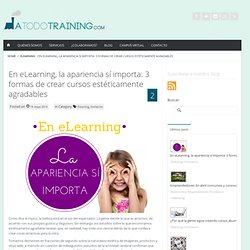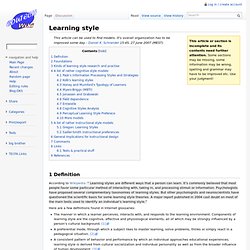

En eLearning, la apariencia sí importa: 3 formas de crear cursos estéticamente agradables » A todo training. Posted on 19, mayo 2014 in Category Elearning, Formación Como dice el tópico, la belleza está en el ojo del espectador.

La gente decide lo que es atractivo, de acuerdo con sus propios gustos y disgustos. Sin embargo, los estudios sobre lo que encontramos estéticamente agradable revelan que, en realidad, hay toda una ciencia detrás de lo que conlleva crear cosas atractivas para la vista. Tomamos decisiones en fracciones de segundo sobre la naturaleza estética de imágenes, productos y sitios web, a menudo en cuestión de milisegundos (estudios de la actividad cerebral confirman que las impresiones estéticas se forman dentro de 300ms a 600ms).
En el desarrollo de eLearning, la calidad estética de un curso puede mejorar los resultados del aprendizaje. Los profesionales de eLearning que entienden que necesitan presentar los contenidos de manera estéticamente agradable, podrán transmitir mejor el contenido. 1) Menos es más: Simplicidad en el diseño O como dice el Dr. Piensa en un jardín zen. Mystery, Curiosity and Surprise - Gamified UK Blog. Most people seem to like surprises and mystery.

It also seems that curiosity has the power to drive us to do strange and counter-intuitive things. We like to know what is in the mystery box, what is behind door number 3, what happens after the season finale, what the red “do not press” button actually does, if we can climb to the top of the rickety looking rope. Curiosity can also be seen around problem solving. Whilst at times we need to solve the problem, there is no need for us to do puzzles like crosswords or to learn languages that we do not really need. These kinds of drives seem to fall in or around curiosity. It is something games make use of all the time.
My curiosity was peaked as I realised that I had no idea why this may be the case – I like to understand these things! There is some research on curiosity and how we deal with it, but it seems that there is no definite answer. Another strand of theory is called incongruity theory. Learning Styles & Technology. Learning style. This article or section is incomplete and its contents need further attention.

Some sections may be missing, some information may be wrong, spelling and grammar may have to be improved etc. Use your judgment! 1 Definition According to Wikipedia: “ Learning styles are different ways that a person can learn. It's commonly believed that most people favor some particular method of interacting with, taking in, and processing stimuli or information.
Here are a few definitions found in Internet glossaries: The manner in which a learner perceives, interacts with, and responds to the learning environment. 2 Foundations Learning style research is related to research on cognitive styles, interaction styles, brain science, etc. “ Conflicting assumptions about learning underpin mainstream ideas about learning and the best-known models of learning styles. “Our findings indicate that cognitive style is a complex variable with multiple dimensions. 3 Kinds of learning style research and practise. Hobbs Professor of Cognition and Education / Harvard Graduate School of Education. Learning styles. Learning style is an individual's natural or habitual pattern of acquiring and processing information in learning situations.

A core concept is that individuals differ in how they learn.[1] The idea of individualized learning styles originated in the 1970s, and has greatly influenced education.[2] Proponents of the use of learning styles in education recommend that teachers assess the learning styles of their students and adapt their classroom methods to best fit each student's learning style. Although there is ample evidence for differences in individual thinking and ways of processing various types of information, few studies have reliably tested the validity of using learning styles in education.[2] Critics say there is no evidence that identifying an individual student's learning style produces better outcomes.
David Kolb's model[edit] David A. David Kolb’s Experiential Learning Model (ELM) [5] 1. 2. 3. 4. Learning Modalities[edit] 1. 2. 3. Descriptions of Learning Modalities: 1. 2. 3.